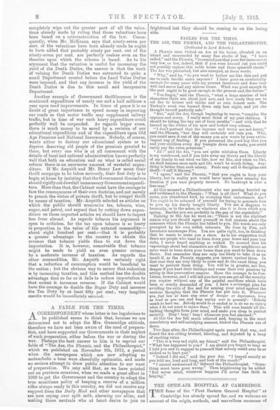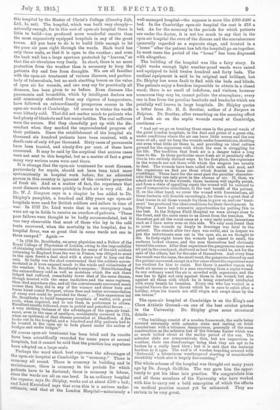THE OPEN-AIR HOSPITAL AT CAMBRIDGE. T HE fame of the "First
Eastern General Hospital" at Cambridge has already spread far, and we welcome an account of the origin, methods, and marvellous successes of this hospital by the Master of Christ's College (Country Life, Ltd., ls. net). The hospital, which was built very cheaply—
naturally enough, for in this sort of open-air hospital there is little to build—has produced more wonderful results than the most expensively equipped hospitals in any of the great towns. All you have to do is to build little enough to let the pure air pass right through the wards. Each ward has only three walls, so that it is open to the weather ; and even the back wall has a large aperture protected by "louvres," so that the air circulates very freely. In short, there is no more protection from the weather than is necessary to keep the patients dry and free from draughts. We are all familiar with the open-air treatment of various diseases, and particu- larly of tuberculosis, but no such startling lesson on the value of open air for wounds, and one may say for practically all
diseases, has been given to us before. Even diseases like pneumonia and bronchitis, which by intelligent doctors are still commonly sheltered from any rigours of temperature, have followed an extraordinarily prosperous course in the open-air wards at Cambridge. Of course in winter the wards were bitterly cold. That did not matter much to patients who had plenty of blankets and hot-water bottles. The real sufferers were the nurses. But they cheerfully put np with the dis- comfort when they marked the unprecedented progress of their patients. Since the establishment of the hospital six thousand six hundred patients have been received, with a death rate of only 4.6 per thousand. Sixty cases of pneumonia have been treated, and ninety-five per cent. of these have recovered. It may be said by the sceptical that serious eases
were not sent to this hospital, but as a matter of fact a great many very serious cases were sent there.
It is strange that the open-air treatment for most diseases, particularly for sepsis, should not have been tried more systematically in hospital work before, for no educated person in this country is ignorant of the curative properties of fresh air. And as a matter of fact, the experience that most diseases abate more quickly in fresh air is very old. As Dr. W. J. Simpson says in a chapter ho has added to Dr. Shipley's pamphlet, a hundred and fifty years ago open-air hospitals were used for British soldiers and sailors in time of war. In 1757 Dr. Lind wrote that in an emergency tents were set up in fields to receive an overflow of patients. "These poor fellows were thought to be badly accommodated, but it was very observable that most of those who lay in the cold tents recovered, when the mortality in the hospital, due to
hospital fever, was so great that in some wards not one in three escaped." Again :—
" In 1768 Dr. Brocklesby, an army physician and a Fellow of the Royal College of Physicians of London, owing to the impossibility of obtaining sufficient accommodation for many of the sick soldiers returning to England from the war in France, was obliged to erect in the open forest a deal shed with a straw roof to keep out the rain. So badly was the shed constructed that the soldiers accom- modated in it were exposed much to the winds and vicissitudes of the weather. Yet, to Dr. Brocklesby's surprise : ' Notwithstanding the extraordinary cold as well as moisture which the sick there lodged had suffered, remarkably fewer died of the same disease, though treated with the same medicines and the same regimen, than died anywhere else, and all the convalescents recovered much sooner than they did in any of the warmer and closer huts and barns hired round Newport, whore fires and better accommodation of every sort could be provided for them.' ... This experience led Dr. Broeklesby to build temporary hospitals of wattle, with good roofs, when required, and to use them in preference to others. Excellent results followed, even in putrid and potechial fevers.. .. A very striking instance of the advantages of the open-air treat- ment, even in the case of smallpox, accidentally occurred in 1731, when an opidemid of that disease prevailed at Blandford. A fire broke out in the hospital, and a hundred and fifty patients had to be treated in the open air in beds placed under the arches of bridges and under hedges."
Of course open-air treatment has been tried and its results have been scientifically recorded for some years at several hospitals, but it cannot be said that the practice has anywhere been adopted on a large scale. Perhaps the word which best expresses the advantages of the open-air hospital at Cambridge is "economy." There is economy all round. There is economy in building and in maintenance; there is economy in the periods for which patients have to be doctored; there is economy in labour, since the wards are all on one leveL In an ordinary hospital the expense, says Dr. Shipley, works out at about £200 a bed; and Lord Knutsford says that even this is a serious under- estimate, and that at the London Hospital—notoriously a well-managed hospital—the expense is more like Z300-£400 a bed. In the Cambridge open-air hospital the cost is £16 a bed. As for the economy in the periods for which patients are under the doctor, it is not too much to say that in the open-air hospital the cure of the disease and the convalescence (generally regarded as a separate stage, and treated in a " home " after the patient has left the hospital) go on together. In most cases the period of the " home" has been dispensed with altogether.
The building of the hospital was like a fairy story. In eight weeks enough light weather-proof wards were raised and equipped to hold twelve hundred and forty beds. The medical equipment is said to be original and brilliant, but Dr. Shipley has some fault to find with the beds and blinds. The patients enjoy a freedom impossible to obtain in a closed ward; there is no smell of iodoform, and visitors, however
numerous they may be, cannot pollute the atmosphere ; every one is free from the peculiar lassitude and headache which are painfully well known in large hospitals. Dr. Shipley quotes a letter from Dr. H. S. Souttar, author of A Surgeon in Belgium. Dr. Souttar, after remarking on the amazing effect of fresh air on the septic wounds cured at Cambridge, continues :-
" And yet we go on treating these cases in the general wards of the groat London hospitals, in the dust and grime of a great city, under conditions where the air can have little access and the sun none at all ; and we bury the wounds under fomentations, shutting out even what little air there is, and providing an ideal culture ground for the organisms with which the man is struggling for his life. The tradition that fresh air is a danger takes a long time to die. In these particular cases fresh air is peculiarly effec- tive in two entirely distinct ways. In the first place, the organisms in the wounds are not those with which the surgeon has usually to deal. The wounds have boon soiled with earth and mud, and the organisms we find are those which flourish in these sur- rouddings. These have for the most part the peculiar character- istic that they can only grow in the absence of air. If, then, we admit air freely to the wounds, those bacteria will rapidly perish. and from a state of appalling sepsis the wound will be reduced to one of comparative cleanliness, to the vast benefit of the patient. If, on the other hand, we cover the wound with fomentations, all these bacteria will flourish exceedingly, for there is a great deal of dead tissue in all these wounds for them to grow on, and our ` treat- ment' has produced the ideal conditions for their development. In Belgium I have had extensive opportunities for putting this to the teat. In the ]3olgian Field Hospital we were always close to the front, and the cases came to us direct from the trenches. We therefore got all the worst cases at a very early point, lacerations such as I have never seen on this side. We very soon found that to cover the wounds up deeply in dressings was fatal to the patient. The stench after two days was awful, and in despair we put the unfortunate men out in the open air, as we thought to die. In forty-eight hours the wounds had ceased to smell, the surfaces looked cleaner, and the men themselves had obviously turned the corner. After that experience the gangrenous cases were all put in the courtyard, sheltered as best they could be, not for the sake of the others, but for the sake of themselves. And every time the result was the same, the smell went, the gangrene cleared up and the patient recovered, except in a few cases where the organisms were too virulent for him to resist. But there is another reason why fresh air moans so much to a man recovering from a septic wound. In any ordinary ward the air is crowded with organisms, and the man has to fight not only against those in his wound, but also against all those with which he is being constantly reinfected with every breath he breathes. Every one who has worked in a hospital knows the sore throat which he is sure to catch after a holiday, when his tonsils are still virgin soil swept dean by the sea breeze."
The open-air hospital at Cambridge is on the King's and Clare Athletic Ground—on one of the best cricket pitches in the University. Dr. Shipley gives some structural
details :—
" The buildings consist of a wooden framework, tho walls being covered externally with asbestos slabs and resting on brick foundations with a bitumen damp-course, generally of the same construction as the asbestos but of the German Kaiser which was so much talked about at the earlier period of the war. The asbestos slabs are comparatively thin, but are impervious to weather, their one disadvantage being that they are apt to be broken by a really hard blow ; but it is said that the material hardens as it ages. The roof is of wooden boarding covered with Ruberoid,' a bituminous weatherproof sheeting of considerable durability which also is largely fire-resisting."
The whole scheme of the hospital was thought out many years
ago by Dr. Joseph Griffiths. The war gave him the oppor- tunity to put his ideas into practice. We congratulate him and all those members of the University who have worked with him to carry out a bold conception of which the effects on medical practice cannot yet be estimated. They are
certain to be very great.











































 Previous page
Previous page